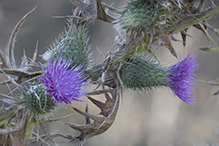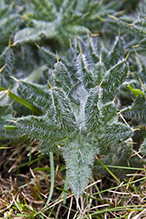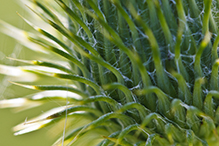bull thistle
(Cirsium vulgare)
Conservation • Weed • Wetland • Description • Habitat • Ecology • Use • Distribution • Taxonomy
Description |
Bull thistle is a 16″ to 78″ tall, erect, biennial forb that rises from a taproot and fibrous roots. The taproot is fleshy, thick, up to 28″ deep, and often branched. In its first year the plant produces a radiating cluster of leaves (rosette) above ground and a large taproot below ground. In the second year it sends up a single erect flowering stem, sometimes also one or more ascending side stems. The plant dies after flowering and setting seeds one time. It does not spread vegetatively. The seeds germinate easily but do not often survive. As a result plants are usually found singly or scattered. The stem is stout, usually well branched, and light green with dark purple veins. It is sparsely to densely covered with long, soft, spreading hairs, at least the middle and upper sections. The upper portion of the stem is conspicuously winged. The sap is clear, not white. The rosette of basal leaves produced in the first year is flat and can be 24″ or more in diameter. The leaves are narrowly elliptic to inversely lance-shaped in outline, 6″ to 16″ long, and 1¼″ to 6″ wide. They are deeply cut into 4 to 6 widely spaced pairs of lobes (pinnatifid) with the lobes further cut into 3 or 4 smaller lobes (bipinnatifid). The ultimate lobes are rigid, triangular to lance-shaped, and tipped with a stout, yellowish, 1 ⁄16″ to ⅜″ long spine. They extend both horizontally and vertically from the plane of the leaf blade and are mostly twisted at the base to face toward the leaf tip, giving the leaf a distinct three-dimensional appearance. The upper surface is dark green with a light green midrib. It is covered with short, straight, white hairs and small yellowish spines. The lower surface is lighter green and is covered with grayish, cobwebby hairs, at least along the veins. The leaves are densely hairy when young and become less hairy as they mature. The margins are spiny. Stem leaves are 1¼″ to 6″ long; stalkless and slightly clasping; and deeply lobed, cut more than half way to the midrib. The lobes are narrow, often linear lance-shaped. The upper surface is covered with stiff, bristly hairs, at least along the veins. Stem leaves are otherwise similar to basal leaves. The blade of the leaf continues down the stem from the point of attachment as a wing that is up to ⅜″ wide. The margins of the wings are armed with spines up to ¼″ long. The wing extends uninterrupted nearly to the leaf below. Middle stem leaves are often more deeply divided than lower leaves. The leaves become progressively smaller but no less divided as they ascend the stem. However, some of the uppermost leaves may be lance-shaped or linear and not divided. The inflorescence is usually a single large flower head, sometimes a loose, branched, cluster (corymb) of 2 to a few large flower heads, at the end of the stem and each branch. The flower heads are stalkless or are borne singly on ⅜″ to 2⅜″ long stalks. The flower heads are subtended by one to several straight, unlobed, linear, spine-tipped, bract-like leaves. At the base of each flower head there are 5 to 12 rows of numerous bracts (phyllaries) forming a hemispheric or bell-shaped base (involucre). The involucre is 1¼″ to 1½″ long and ¾″ to 1½″ wide, slightly longer than wide. It is loosely covered with cobwebby hairs, at least near the base. The lower and middle phyllaries are linear lance-shaped, curve outwards, and are long tapered to a spiny, straw-colored, 1 ⁄16″ to 3 ⁄16″long tip. The inner phyllaries are linear. The flower heads are to 1½″ to 2″ in diameter. They have numerous tubular, 1″ to 1⅜″ long disk florets. The disk florets are reddish-purple or purple, rarely white. The fruit is a ⅛″ to 3 ⁄16″ long seed capsule (cypsela). The cypsela is light brown and sometimes has dark longitudinal streaks. The collar near the tip is inconspicuous. There is a tuft of white or light tan hairs at the tip. |
Height |
16″ to 78″ |
Flower Color |
Purple |
Similar Species |
Habitat |
Moist to dry. Prairies, pastures, abandoned fields, forest openings, roadsides, railroads, disturbed sites. Full sun. |
Ecology |
Flowering |
Late June to August |
Pests and Diseases |
|
Use |
|
Distribution |
||
|
Sources |
|
| 9/3/2024 | ||
Nativity |
||
Native of Northern Africa, Asia, and Europe. Introduced in the United States; naturalized. The exact date and location of this species’ introduction is not known. It is thought to have been introduced into North America by European settlers, possibly as a seed contaminant, in the early 1800s. |
||
Occurrence |
||
Common and widespread |
||
Taxonomy |
|
Kingdom |
|
Subkingdom |
Pteridobiotina |
Phylum |
Tracheophyta (Vascular Plants) |
Class |
|
Order |
Asterales (Sunflowers, Bellflowers, Fanflowers, and Allies) |
Family |
Asteraceae (Sunflowers, Daisies, Asters, and Allies) |
Subfamily |
Carduoideae (thistles and allies) |
Tribe |
Cardueae |
Subtribe |
Carduinae (thistles and burdocks) |
Genus |
Cirsium (plume thistles) |
Subordinate Taxa |
|
Cirsium vulgare ssp. crinitum Cirsium vulgare ssp. silvaticum Cirsium vulgare ssp. vulgare Cirsium vulgare var. litorale |
|
Synonyms |
|
Carduus lanceolatus Carduus vulgaris Cirsium lanceolatum Cirsium lanceolatum var. hypoleucum |
|
Common Names |
|
bull thistle common thistle spear thistle |
|
Glossary
Bipinnatifid
Twice pinnatifid. Cut deeply into lobes with each lobe also cut into deep lobes.
Bract
Modified leaf at the base of a flower stalk, flower cluster, or inflorescence.
Clasping
Describing a leaf that wholly or partly surrounds the stem but does not fuse at the base.
Corymb
A flat-topped or convex inflorescence in which the stalked flowers grow upward from various points on the main stem to approximately the same horizontal plane. The outer flowers open first.
Cypsela
A dry, one-chambered, single-seeded fruit, formed from a single carpel, with the seed attached to the membranous outer layer (wall) only by the seed stalk; the wall, formed from the wall of the inferior ovary and also from other tissues derived from the receptacle or hypanthium, does not split open at maturity, but relies on decay or predation to release the contents.
Involucre
A whorl of bracts beneath or surrounding a flower, flower head, or flower cluster.
Linear
Long, straight, and narrow, with more or less parallel sides, like a blade of grass.
Phyllary
An individual bract within the involucre of a plant in the Asteraceae family.
Pinnatifid
Deeply cut, more than half way to the midrib but not to the midrib, into lobes that are spaced out along the midrib; the lobes do not form separate leaflets.
Rosette
A radiating group or cluster of leaves usually on or close to the ground.
Wing
A thin, flat, membranous, usually transparent appendage on the margin of a structure.
Visitor Photos |
||
Share your photo of this plant. |
||
This button not working for you? |
||
Alfredo Colon |
 |
Robert Briggs |
||
 |
 |
|
Bill Reynolds |
||
 |
 |
|
Here are two images of Bull Thistle just before bloom In Pennington Co. MN. |
||
 |
 |
|
Plant |
||
MinnesotaSeasons.com Photos |
||
 |
 |
|
Basal rosette |
||
|
||
|
||
Plant |
|
|
 |
 |
|
Basal leaves |
Basal leaves |
|
 |
||
Basal leaves |
|
|
 |
 |
|
Winged stem |
Involucre |
|
 |

|
|
Phyllaries |
||
|
||
|
Phyllaries |

Slideshows |
Spear Thistle |

|
About
Spear Thistle (Cirsium vulgare). |
Cirsium vulgare |

|
About
Introduced taprooted biennial often over 1 m tall, both leaf surfaces typically greenish and not covered by dense woolly hairs, upper leaf surfaces covered by minute spines or prickles, common where disturbance is frequent, such as roadsides and pastures. |
Bull Thistle (Spear Thistle) (Cirsium vulgare) |

|
Cirsium vulgare BULL THISTLE |

|

Visitor Videos |
||
Share your video of this plant. |
||
This button not working for you? |
||
|
Other Videos |
||
Identifying Bull Thistle, Cirsium vulgare |
About
Uploaded on Jan 2, 2012 How to identify Bull Thistle, Cirsium vulgare, also known as Spear Thistle or Common Thistle. www.mynatureapps.com |
Bull Thistle (Cirsium vulgare) ~ Invasive Species |
About
Published on Feb 10, 2014 Bull Thistle (Cirsium vulgare), also known as Spear Thistle, in the East Kootenays of British Columbia. It is a native plant of most of Europe, Western Asia, and NW Africa. In North America and Australia it has become naturalised and is a widespread weed often found colonising disturbed ground. It is a member of the Sunflower (Asteraceae) family. The flowers are a favourite with bees and butterflies (and on this day, ants). Lacking natural predators and diseases, invasive plant species grow and spread rapidly throughout native ecosystems. Once established, invasive plants are very difficult to control and they choke out native species. This greatly affects wildlife habitat and rangeland. On a global scale, invasive pant and animal species are considered to be the second largest contributor to the loss of biodiversity, next to the loss of habitat. |
Environmental Laboratory - U.S. Army Corps of Engineers |
About
Published on Feb 15, 2013 Cirsium vulgare - Bull Thistle |
Weed of the Week #654-Bull Thistle (Air Date 10/17/10) |
About
Uploaded on Oct 20, 2010 Don't sit on this weed. No, really, don't SIT on this weed. It's our Weed of the Week, Bull Thistle. |

Visitor Sightings |
||
Report a sighting of this plant. |
||
This button not working for you? |
||
| Alfredo Colon 7/7/2024 |
Location: Albany, NY |
 |
| Bill Reynolds 8/1/2014 |
Location: Pennington Co. MN I didn't know these existed. The Bull Thistle is just starting to bloom here in the north west of Minnesota. The first two open are white. |
 |
| Bill Reynolds 8/17/2013 |
Location: Pennington Co. MN Bull Thistle just before bloom In Pennington Co. MN. |
 |
| Bill Reynolds 8/11/2013 |
Location: Pennington Co. MN Bull Thistle just before bloom In Pennington Co. MN. |
 |
MinnesotaSeasons.com Sightings |
||
Avon Hills Forest SNA, North Unit Bertram Chain of Lakes Regional Park Cedar Creek Ecosystem Science Reserve Clifton E. French Regional Park Clinton Falls Dwarf Trout Lily SNA Forestville/Mystery Cave State Park John Peter Hoffman Spring Brook Valley WMA Northern Tallgrass Prairie NWR, Hoffman Unit Northern Tallgrass Prairie NWR, Pavia Unit Northern Tallgrass Prairie NWR, Touch the Sky Prairie Unit Prairie Creek WMA, Koester Prairie Unit Richard M. & Mathilde Rice Elliott SNA Sand Prairie Wildlife Management and Environmental Education Area Spring Beauty Northern Hardwoods SNA |

|
Created: 5/6/2009 Last Updated: © MinnesotaSeasons.com. All rights reserved. |
